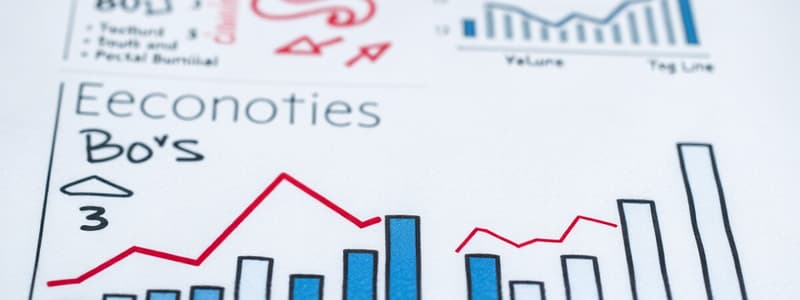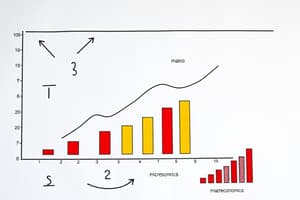Podcast
Questions and Answers
What is the primary focus of microeconomics?
What is the primary focus of microeconomics?
- Aggregate economic indicators
- Individual and business decision-making (correct)
- National income and inflation rates
- Government spending and taxation
Which market structure is characterized by many buyers and sellers with homogeneous products?
Which market structure is characterized by many buyers and sellers with homogeneous products?
- Perfect Competition (correct)
- OLigopoly
- Monopoly
- Monopolistic Competition
What happens to the quantity demanded when prices increase, according to the law of demand?
What happens to the quantity demanded when prices increase, according to the law of demand?
- Quantity demanded decreases (correct)
- Quantity demanded fluctuates unpredictably
- Quantity demanded increases
- Quantity demanded remains the same
Which economic indicator reflects the total value of goods and services produced within a country?
Which economic indicator reflects the total value of goods and services produced within a country?
Which policy involves government actions to influence the economy through spending and taxation?
Which policy involves government actions to influence the economy through spending and taxation?
What is the term for the barriers that prevent new firms from entering a monopoly market?
What is the term for the barriers that prevent new firms from entering a monopoly market?
What economic theory emphasizes minimal government intervention and trusts in free market dynamics?
What economic theory emphasizes minimal government intervention and trusts in free market dynamics?
How does an increase in inflation typically affect purchasing power?
How does an increase in inflation typically affect purchasing power?
Flashcards are hidden until you start studying
Study Notes
Key Concepts in Economics
-
Definition of Economics
- Study of how individuals, businesses, and governments allocate scarce resources.
- Focus on production, consumption, and distribution of goods and services.
-
Microeconomics vs. Macroeconomics
- Microeconomics
- Examines individual and business decisions.
- Analyzes supply and demand, price elasticity, and consumer behavior.
- Macroeconomics
- Looks at the economy as a whole.
- Studies aggregate indicators like GDP, unemployment rates, inflation, and national income.
- Microeconomics
-
Basic Economic Problems
- Scarcity: Limited resources versus unlimited wants.
- Choice: Decisions necessary due to scarcity, leading to opportunity costs.
-
Supply and Demand
- Law of Demand
- As price decreases, quantity demanded increases, and vice versa.
- Law of Supply
- As price increases, quantity supplied increases, and vice versa.
- Equilibrium Price
- Point where quantity supplied equals quantity demanded.
- Law of Demand
-
Market Structures
- Perfect Competition
- Many buyers and sellers, homogeneous products, free entry and exit.
- Monopoly
- Single seller controls the market, unique product with high barriers to entry.
- Oligopoly
- Few sellers dominate the market, products may be similar or differentiated.
- Monopolistic Competition
- Many firms, differentiated products, some control over prices.
- Perfect Competition
-
Economic Indicators
- Gross Domestic Product (GDP)
- Total value of all goods and services produced in a country.
- Unemployment Rate
- Percentage of the labor force that is jobless and actively seeking work.
- Inflation Rate
- Percentage increase in prices over a period, affecting purchasing power.
- Gross Domestic Product (GDP)
-
Fiscal and Monetary Policy
- Fiscal Policy
- Government spending and taxation decisions to influence the economy.
- Monetary Policy
- Central bank actions to control money supply and interest rates, affecting inflation and consumption.
- Fiscal Policy
-
International Economics
- Trade: Import/export of goods and services between countries.
- Exchange Rates: Value of one currency in terms of another.
-
Key Economic Theories
- Keynesian Economics: Advocates for government intervention to stabilize economic fluctuations.
- Classical Economics: Emphasizes free markets and limited government involvement.
- Supply-Side Economics: Focuses on boosting economic growth through tax cuts and deregulation.
Important Economic Terms
- Opportunity Cost: The cost of the next best alternative forgone when making a choice.
- Elasticity: Measurement of how much demand or supply changes in response to price changes.
- Market Failure: A situation where the allocation of goods and services is not efficient, leading to welfare loss.
Summary
Economics is a broad subject focusing on resource allocation, market mechanics, and overall economic health. Understanding its principles aids in analyzing real-world problems and formulating strategies for improvement.
Definition of Economics
- Studies how individuals, businesses, and governments allocate scarce resources.
- Focuses on production, consumption, and distribution of goods and services.
Microeconomics vs. Macroeconomics
- Microeconomics examines individual and business decisions.
- Macroeconomics looks at the economy as a whole.
Basic Economic Problems
- Scarcity: Limited resources versus unlimited wants.
- Choice: Decisions are necessary due to scarcity, leading to opportunity costs.
Supply and Demand
- Law of Demand: As price decreases, quantity demanded increases, and vice versa.
- Law of Supply: As price increases, quantity supplied increases, and vice versa.
- Equilibrium Price: Point where quantity supplied equals quantity demanded.
Market Structures
- Perfect Competition: Many buyers and sellers, homogeneous products, free entry and exit.
- Monopoly: Single seller controls the market, unique product with high barriers to entry.
- Oligopoly: Few sellers dominate the market, products may be similar or differentiated.
- Monopolistic Competition: Many firms, differentiated products, some control over prices.
Economic Indicators
- Gross Domestic Product (GDP): Total value of all goods and services produced in a country.
- Unemployment Rate: Percentage of the labor force that is jobless and actively seeking work.
- Inflation Rate: Percentage increase in prices over a period, affecting purchasing power.
Fiscal and Monetary Policy
- Fiscal Policy: Government spending and taxation decisions to influence the economy.
- Monetary Policy: Central bank actions to control money supply and interest rates, affecting inflation and consumption.
International Economics
- Trade: Import/export of goods and services between countries.
- Exchange Rates: Value of one currency in terms of another.
Key Economic Theories
- Keynesian Economics: Advocates for government intervention to stabilize economic fluctuations.
- Classical Economics: Emphasizes free markets and limited government involvement.
- Supply-Side Economics: Focuses on boosting economic growth through tax cuts and deregulation.
Important Economic Terms
- Opportunity Cost: The cost of the next best alternative forgone when making a choice.
- Elasticity: Measurement of how much demand or supply changes in response to price changes.
- Market Failure: A situation where the allocation of goods and services is not efficient, leading to welfare loss.
Studying That Suits You
Use AI to generate personalized quizzes and flashcards to suit your learning preferences.




